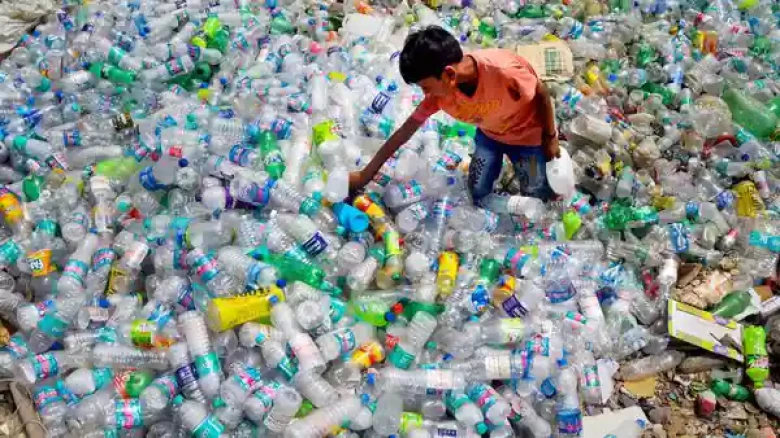North East

India is rated 94th out of 100 countries in terms of single-use plastic waste output, according to the survey (the top three being Singapore, Australia, and Oman). Based on local output of 11.8 MMT and imports of 2.9 MMT, India's next generation of single-use plastic rubbish is 5.6 MMT, with per capita creation of 4 kg.
Digital Desk: The usage of "single-use plastic"
will be prohibited at the Centre beginning July 1. Last year, the Ministry of
Environment, Forestry, and Climate Change issued a gazette notice announcing
the restriction, and it has already produced a list of items that would be
restricted beginning next month.
The Ministry statement adds, "With
effect from July 1, 2022, the manufacturing, import, stocking, distribution,
sale, and use of the following single-use plastic commodities, including
polystyrene and expanded polystyrene, shall be forbidden."
mso-border-alt:none windowtext 0in;padding:0in;font-weight:normal">What is
single-use plastic?
As the name says, it refers to plastic
items that are used once and then discarded. Packaging, bottles (shampoo,
detergents, cosmetics), polythene bags, face masks, coffee cups, cling film,
rubbish bags, food packaging, and other single-use plastics account for a major
share of all plastic made and used.
According to the Minderoo Foundation's
report from 2021, single-use plastics account for a third of all plastic
manufactured globally, with 98 percent derived from fossil fuels. According to
the study, the majority of plastic disposed is single-use plastic, which
accounts for 130 million metric tonnes globally in 2019, "all of which is
burned, buried in landfills, or thrown directly into the environment."
minor-latin;color:#3E3E3E">Based on current production rates, single-use
plastic is expected to contribute for 5-10% of greenhouse gas emissions by
2050.
mso-fareast-font-family:Calibri;mso-fareast-theme-font:minor-latin;color:#3E3E3E">India
is rated 94th out of 100 countries in terms of single-use plastic waste output,
according to the survey (the top three being Singapore, Australia, and Oman).
Based on local output of 11.8 MMT and imports of 2.9 MMT, India's next
generation of single-use plastic rubbish is 5.6 MMT, with per capita creation
of 4 kg.
color:#3E3E3E;border:none windowtext 1.0pt;mso-border-alt:none windowtext 0in;
padding:0in;font-weight:normal;mso-bidi-font-weight:bold">
color:#3E3E3E;border:none windowtext 1.0pt;mso-border-alt:none windowtext 0in;
padding:0in;font-weight:normal;mso-bidi-font-weight:bold">What are the items
being banned?
Earbuds, balloon sticks, candy and
ice-cream sticks; cutlery goods such as plates, cups, glasses, forks, spoons,
knives, and trays; sweet boxes; invitation cards; cigarette packs; PVC banners
measuring less than 100 microns; and polystyrene for decoration have all been
banned by the Central Pollution Control Board (CPCB).
The Ministry banned polythene bags with a
thickness of less than 75 microns in September 2021, up from the previous
restriction of 50 microns. The restriction will be extended to polythene bags
with a thickness of less than 120 microns beginning in December. The
prohibition is being phased in to give companies time to switch to thicker
polythene bags that are easier to recycle, according to Ministry officials. While
producers can use the same process to make 50- and 75-micron bags, the
machinery for 120 micron bags will need to be modified.
Plastic sachets used for storing, packing,
or selling gutkha, tobacco, or pan masala are also prohibited under the Plastic
Waste Management Rules of 2016.
color:#3E3E3E">According to ministry officials, the decision to restrict the
first batch of single-use plastic goods was based on "difficulty of
collecting, and thus recycling."
color:#3E3E3E">
color:#3E3E3E">"The enemy is the presence of plastic in the ecosystem, not
the presence of plastic in general." When plastic remains in the
environment for a lengthy amount of time without decomposing, it dissolves into
microplastics, posing a serious health risk. Microplastics get into our food
and subsequently into our bodies, providing a major health danger. These items
were chosen because they are difficult to gather, particularly because the
majority are small or thrown away straight into the environment, such as ice
cream sticks. "Unlike the considerably larger fragments, it becomes
impossible to collect for recycling." According to a Ministry
representative, Satish Sinha of the environmental group Toxic Links called the
things chosen "low-hanging fruit."
color:#3E3E3E">
color:#3E3E3E;border:none windowtext 1.0pt;mso-border-alt:none windowtext 0in;
padding:0in;font-weight:normal;mso-bidi-font-weight:bold">How will the ban be
enforced?
color:#3E3E3E">
color:#3E3E3E;border:none windowtext 1.0pt;mso-border-alt:none windowtext 0in;
padding:0in;font-weight:normal;mso-bidi-font-weight:bold">
The
CPCB the Centre, as well as the State Pollution Control Boards (SPCBs), shall
monitor the moratorium and report to the Centre on a regular basis. Directives
have been issued at the national, state, and local levels — for example, to all
petrochemical industries - not to provide raw materials to enterprises that
make the prohibited commodities.
SPCBs and Pollution Control Committees have
also been given orders to change or withdraw authorizations to operate provided
under the Air/Water Act to businesses that manufacture single-use plastic
items. Local governments have been told to issue new commercial licences with
the condition that SUP items are not sold on their property, and current
commercial licences will be cancelled if these items are found to be sold. The
CPCB gave one-time certificates to 200 compostable plastic makers last week,
and the BIS approved biodegradable plastic standards.
Those who break the ban face penalties
under the Environment Protection Act 1986, which include up to 5 years in
prison, a fine of up to Rs 1 lakh, or both.
The SPCB may also demand that violators pay
Environmental Damage Compensation. There are also local rules on plastic
garbage that have their own penal codes.
Leave A Comment